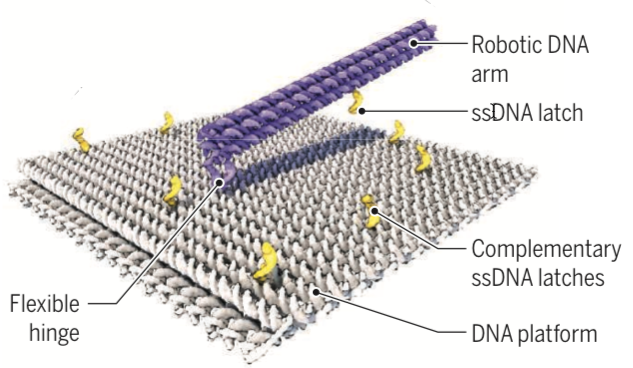Remote-controlled DNA nanorobots could lead to the first nanorobotic production factory
January 19, 2018

German researchers created a 55-nm-by-55-nm DNA-based molecular platform with a 25-nm-long robotic arm that can be actuated with externally applied electrical fields, under computer control. (credit: Enzo Kopperger et al./Science)
By powering a self-assembling DNA nanorobotic arm with electric fields, German scientists have achieved precise nanoscale movement that is at least five orders of magnitude (hundreds of thousands times) faster than previously reported DNA-driven robotic systems, they suggest today (Jan. 19) in the journal Science.
DNA origami has emerged as a powerful tool to build precise structures. But now, “Kopperger et al. make an impressive stride in this direction by creating a dynamic DNA origami structure that they can directly control from the macroscale with easily tunable electric fields—similar to a remote-controlled robot,” notes Björn Högberg of Karolinska Institutet in a related Perspective in Science, (p. 279).

The nanorobotic arm resembles the gearshift lever of a car. Controlled by an electric field (comparable to the car driver), short, single-stranded DNA serves as “latches” (yellow) to momentarily grab and lock the 25-nanometer-long arm into predefined “gear” positions. (credit: Enzo Kopperger et al./Science)
The new biohybrid nanorobotic systems could even act as a molecular mechanical memory (a sort of nanoscale version of the Babbage Analytical Engine), he notes. “With the capability to form long filaments with multiple DNA robot arms, the systems could also serve as a platform for new inventions in digital memory, nanoscale cargo transfer, and 3D printing of molecules.”
“The robot-arm system may be scaled up and integrated into larger hybrid systems by a combination of lithographic and self-assembly techniques,” according to the researchers. “Electrically clocked synthesis of molecules with a large number of robot arms in parallel could then be the first step toward the realization of a genuine nanorobotic production factory.”
Taking a different approach to a nanofactory, this “Productive Nanosystems: from Molecules to Superproducts” film — a collaborative project of animator and engineer John Burch and pioneer nanotechnologist K. Eric Drexler in 2005 — demonstrated key steps in a hypothetical process that converts simple molecules into a billion-CPU laptop computer. More here.
Abstract of A self-assembled nanoscale robotic arm controlled by electric fields
The use of dynamic, self-assembled DNA nanostructures in the context of nanorobotics requires fast and reliable actuation mechanisms. We therefore created a 55-nanometer–by–55-nanometer DNA-based molecular platform with an integrated robotic arm of length 25 nanometers, which can be extended to more than 400 nanometers and actuated with externally applied electrical fields. Precise, computer-controlled switching of the arm between arbitrary positions on the platform can be achieved within milliseconds, as demonstrated with single-pair Förster resonance energy transfer experiments and fluorescence microscopy. The arm can be used for electrically driven transport of molecules or nanoparticles over tens of nanometers, which is useful for the control of photonic and plasmonic processes. Application of piconewton forces by the robot arm is demonstrated in force-induced DNA duplex melting experiments.